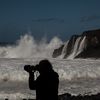Lovelier in Black
Die feinkörnigen schwarzen Strände im Süden Islands bestehen aus vulkanischem Basaltsand, der aus der Verwitterung von Klippen und Gängen, die als Felsnadeln im Meer stehen, stammt. Große Mengen stammen zusätzlich von sogenannten Jökulhlaups. Solche Gletscherläufe entstehen, wenn sich Vulkanausbrüche unter dem Eis ereignen. Sie liefern im Schmelzwasser transportierte Aschen und Pyroklastika an die Küste. Der Sand wird in einem Zickzackmuster entlang der Küste transportiert. Dies geschieht durch den Winkel zwischen auflaufenden Wellen und dem ablaufenden Wasser. Die Richtung der Wellen ist von der Windrichtung abhängig. Das rücklaufende Wasser fließt dagegen immer senkrecht zum Strand ins Meer zurück, da es der Schwerkraft folgt. Dieser Sedimenttransport wird von Strömungen und Gezeiten überlagert. Bei Mondauf- und Untergang ist jeweils Flut. Die warme Irmingerströmung ist ein Rezirkulationsast des Golfstroms. Dadurch bleibt die Wassertemperatur an Islands Küsten ganzjährig über dem Gefrierpunkt. Die vulkanische Plattform Islands erstreckt sich 90 km über die Küstenlinie hinaus. Dort liegt die Wassertiefe erst bei 300 bis 400 m. Jenseits fällt die Meerestiefe sanft auf 2000 bis 3000 m ab.
Juli 2010
Canon 5D MkII, Canon L 16-35 mm, f/16, 5 Sek, 50 ASA, Stativ
Mehr Information:
www.lichtjahre.eu
Where Geoscience Meets Art
---
The fine-grained black beaches in southern Iceland consist of volcanic sand of eroded basaltic cliffs and dykes that appear in the form of rock spires. Additionally, vast amounts of black sand also originate from so called jökulhlaups. These flooding events are caused by volcanic eruptions below the ice and result in torrential meltwater streams that transport fine grained ash and pyroclastica into the ocean. The sandy volcanic sediment is transported laterally along the beach in a zigzag pattern. This is due to the residual angle between the incoming waves and outgoing backwash. Incoming waves approach the beach under oblique angles that depend on the local wind while the backwash is always orthogonal to the beach as it is just gravity driven. This transport is superimposed by local currents and the tides. The moonrise indicates high tide. The warm Irminger current is a recirculation branch of the Gulfstream. Hence, the Atlantic Ocean water temperature around the coastlines of Iceland remains above freezing level throughout the year. The volcanic platform of Iceland extends for another 90 km (56 mi) outward to the sea where the water depth reaches 300 to 400 m (1000 to 1300 ft). Beyond, the ocean floor gently slopes down to a depth of 2000 to 3000 m (6000 to 9000 ft).
July 2010
Canon 5D MkII, Canon L 16-35 mm, f/16, 5 sec, ISO 50, tripod
More information:
www.lichtjahre.eu
Where Geoscience Meets Art





















fabrizio bertini 28/01/2013 19:18
complimenti bellissima immagine+++++++ciao fabrizio
bayucca 21/11/2011 10:45
Super!!Christiane Steinicke 17/08/2011 21:41
Wow, ist das schön, berauschend vom Licht, den Farben und der beeindruckenden Qualitätlg
°Diotima° 13/07/2011 22:44
Was für ein grandioses Schauspiel. Zum Heulen schön!lg
Corry DeLaan 11/07/2011 22:28
Ausgezeichnet!LG, Corry
Stefan Thaler - thalerst 28/04/2011 20:24
Ein Traum..wundervolles Bild!Gisa K. 29/03/2011 16:05
Einfach eine Traum Aufnahme- auch die Info ist sehr gutLG Gisa
My Point Of View 09/03/2011 14:04
5 Sekunden waren perfekt...Bewegungsunschärfe in den Wellen, in dem zurücklaufendem Wasser. Einfach geniale Bewegungsunschärfe ab dem Vordergrund und die sich dadurch ergebenden Linien, die in das Bild hinein führen. Sehr gelungene Aufnahme. Gefällt mir sehr gut!
Gruß
Rafael
Bernd Schäfer 04/03/2011 21:06
licht und zeit in perfekter harmonieV. Schneider 25/02/2011 8:37
traumhafte Aufnahme! Die Stimmung des Abends und das zurücklaufende Wasser hast du super im Bild festgehalten ;-)Gruß Volker
Gabi Anna 06/12/2010 21:29
beeindruckend...!!!
Polarfuchs 2 27/11/2010 12:45
Wunderbar!Monika Drobez 25/11/2010 15:13
Nocheinmal:GRANDIOS!!!
L.G.
Monika
Stefan Schnese 23/11/2010 20:20
Sehr schön !Stefan
GFin 23/11/2010 18:06
Nice picture!! Well done